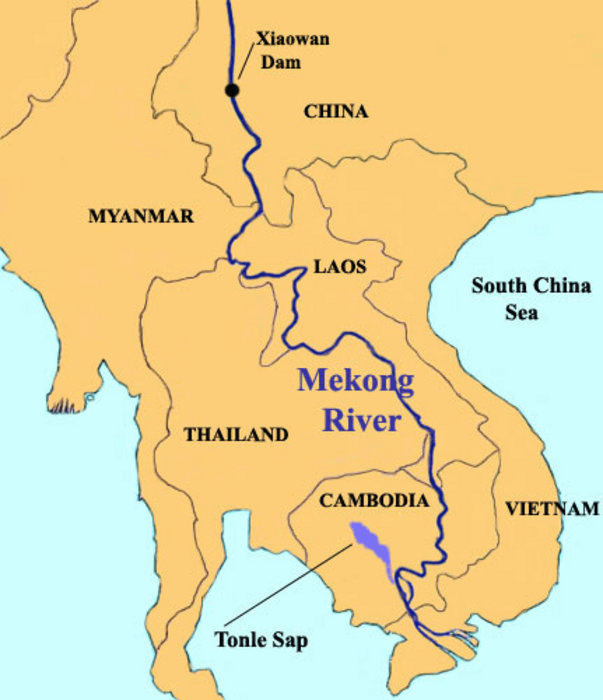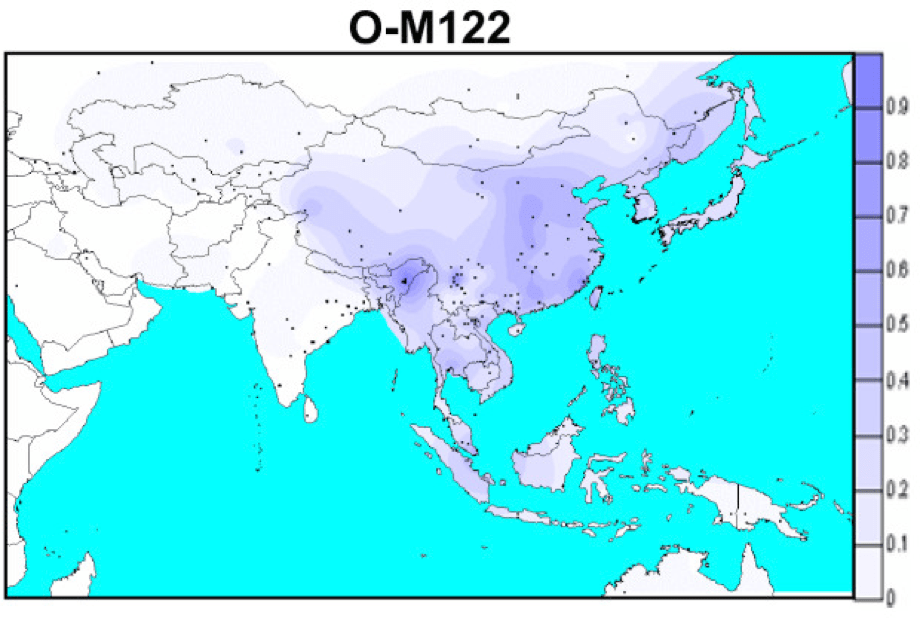Chapter VI
There are exceptions to every rule in family living together, as per point number one in the introduction. We will encounter two significant exceptions amongst Japheth’s grandsons, with the first being the youngest son of Gomer and his prompt decision to dwell apart from his siblings. Togarmah is highlighted as a people with military capability and forms a prominent part of the formidable alliance with Magog and Gomer’s other sons [refer Chapter V Gomer: Continental South East Asia and Chapter X China: Magog, Tubal & Meshech].
Book of Jasher 10:10-12
10 And the children of Tugarma are ten families, and these are their names: Buzar, Parzunac, Balgar, Elicanum, Ragbib, Tarki, Bid, Zebuc, Ongal and Tilmaz; all these spread and rested in the north and built themselves cities. 11 And they called their cities after their own names, those are they who abide by the rivers Hithlah and Italac unto this day. 12 But the families of Angoli, Balgar and Parzunac, they dwell by the great river Dubnee; and the names of their cities are also according to their own names.
Ancient Civilisation:
‘Encyclopaedia Britannica says that the Armenians traditionally claim to be descended from Togarmah… Ancient Armenia reached into Turkey. The name Turkey probably comes from Togarmah.’
We will see repeatedly on our journey, nations claiming to be a Bible identity though this does not make it so.
Israel a History of:
‘The Jewish Targums claim that Germany was also derived from Togarmah and his descendants. Turkey and Turkestan also have possible connections with Togarmah.’
Derek Walker – emphasis & bold mine:
‘Togarmah is another country aligned with Russia [Russia is not Magog, Meshech or Tubal]. He was a son of Gomer, son of Japheth (Genesis 10:1-3), known in Assyrian records as Tilgarimmu, a city state in Eastern Anatolia (Asia Minor, modern Turkey)… This identification is generally acknowledged by all. The Bible confirms Togarmah’s location in Ezekiel 38:6: “Beth-Togarmah from the uttermost parts of the north with all its troops.” The word Beth at the beginning of the word is the Hebrew word for “house.” It means “house or place of Togarmah.” In Ezekiel 38:6: “the house of Togarmah, and all its hordes” are specifically pointed out as being from the north.
Therefore we know it is directly north of Israel [the sons of Jacob – not the State of Israel]. Some of the sons of Togarmah can be traced to the Turkoman tribes of Central Asia. Rimmer had no doubts that Togarmah is ancient Armenia (most of which is in Turkey today…) and cited certain Assyrian chronicles as well as Tacitus in support of his view. He said that the title the House of Togarmah is a common description for Armenia in Armenian literature.
All agree to identify Togarmah with Armenia and Turkey. This fits Ezekiel, for Turkey is directly north of Israel. There’s a possible etymological connection between the names Togarmah and Turkey and Turkestan. In Ezekiel’s time, there was a city in Cappodocia (Turkey) known as Tegarma, Tagarma, Til-garimmu, and Takarama. It’s significant that [four] of the ancient locations Ezekiel gives are found today in the nation of Turkey. Clearly God is emphasising Turkey’s important part in the end-time coalition…’
The location of Togarmah in Asia Minor if accurate, relates to thousands of years ago, directly after the flood [refer Chapter I Noah Antecessor Nulla]. Many peoples have dwelt at this major continental intersection at one time or another; migrating as new peoples encroached. All these different groups of people cannot now still be living there, or all be called Turks.
Dr Hoeh in his 1957, Plain Truth article adds:
‘One branch of the family of Gomer, however, did not journey to Southeast Asia. Ezekiel 38:6 explains it: “The house of Togarmah in the uttermost parts of the north, and all his bands” (Jewish translation). The far, far north means Russian Siberia today! That is where the descendants of Togarmah (Genesis 10:3) live. These Asiatics are still a wild nomadic people, much as they were 2500 years ago, trading “with horses and horsemen and mules” (Ezekiel 27:14).’
The descendants of Togarmah figure more prominently in world affairs than as non-specifically identified nomadic, tribal, horsemen. The two scriptures mentioned by Dr Hoeh pertaining to Togarmah:
Ezekiel 27:14
New Century Version
14 People of Beth Togarmah traded your goods for work horses, war horses, and mules.
This verse today, with a modern application, is revealing a people who are economically and technically advanced; producing machinery and transport for industry and arms weaponry.
Ezekiel 38:6 English Standard Version, translates as quoted by Hoeh.
Gomer and all his hordes; Beth-togarmah from the uttermost parts of the north with all his hordes – many peoples are with you.
Derek Walker explained the meaning of Beth as house. It is a family unit. Its use is showing Togarmah as a separate entity from his brothers Ashkenaz and Riphath. We learned when studying Madai, that Asshur or Assyria lives in the north. There are not many options in Central and East Asia for who Togarmah might be today. Other translations state:
New Century Version
… the nation of Togarmah from the far north…
New English Translation
… and by Beth Togarmah from the remote parts of the north…
There are only four peoples or five nations, which Togarmah could be: China, Mongolia, North Korea, South Korea and Japan.
Youngs Literal Translation
… The house of Togarmah of the sides of the north…
This is a more specific translation and eliminates China and Mongolia.
Modern King James version
… the house of Togarmah from the recesses of the north…
This translation effectively eliminates Japan, for the connotation of this word is a bend, a crook or even a hook. In the King James version it says ‘of the north quarters’. North in Hebrew, tsaphon from the root H6845 tsaphan, signifies ‘hidden, stored up, dark, gloomy’ and ‘unknown.’ Quarters in Hebrew, from H3411: yrekah meaning side or sides [used 21 times in KJV], coasts [3], parts [2], border [1], quarters [1]. It also means ‘flank, extreme parts, the rear or recess’ and ‘recesses.’
The Peninsula jutting out from the Asian continent with the Democratic People’s Republic of Korea in the north and the Republic of Korea in the South, is the clear answer to where Togarmah is located today. This was not obvious until looking at this verse very closely. I had initially considered that Meshech and Tubal were North and South Korea respectively and Japan was Togarmah. Though only Korea, could equate to being tucked away and hidden in a crook or recess.

Korea was split in two in 1945 and unlike North and South Vietnam does not look like uniting anytime soon. The use of House of Togarmah in Ezekiel 38:6, may hint at just one of the Koreas being part of the military alliance with Magog and the rest of Gomer – or, it might be revealing the eventual unification of Korea.
Abarim Publications:
‘The name Togarmah most likely originated in a language other than Hebrew, and therefore does not occur as a word in the Hebrew language. But, transliterated as is, at the heart of the name Togarmah sits the common Hebrew noun (gerem), bone, which figuratively is used to mean self or strength. It comes from the verb (garam), meaning to lay aside or save… The verb [garam] means to leave over, to save for later… to break bones [or breaking bones].’
Recall the names of Gomer, Riphath and Askenaz: ‘Bring to an end’, ‘Crushers’, ‘fire is scattered’ or ‘sprinkling of blood’ [refer Chapter V Gomer: Continental South East Asia]. Further dread then, with the addition of ‘Bone breaker’ to this formidable list of adversaries.
Readers paying careful attention, may remember this quote earlier from the preceding chapter on Gomer – emphasis & bold mine:
‘The study said that Vietnamese people were the only population in the study’s phylogenetic analysis that did not reflect a sizable genetic difference between East Asian and Southeast Asian populations. Jung Jongsun et al. (2010) said that genetic structure analysis found significant admixture in “Vietnamese (or Cambodian) with unknown Southern original settlers.” The study said that it used Cambodians and Vietnamese to represent “Southern people,”… The study also said that Vietnamese people are located between Chinese and Cambodian people in the study’s genome map.’
Bhak Jong-hwa, a professor in the biomedical engineering department at the Ulsan National Institute of Science and Technology (UNIST) states:
‘… the ancient Vietnamese, which was a population that flourished with rapid agricultural development after 8,000 BC, slowly travelled north to ancient civilizations in the Korean peninsula and the Russian Far East. Bhak said that Korean people were formed from the admixture of agricultural Southern Mongoloids from Vietnam who went through China – [According to most linguists and archaeologists with expertise in ancient Korea, the linguistic homeland of proto-Korean and of the early Koreans is located somewhere in Manchuria, particularly the Liao River.] – and hunter-gatherer Northern Mongoloids in the Korean Peninsula. Bhak said, “We believe the number of ancient dwellers who migrated north from Vietnam far exceeds the number of those occupying the peninsula,” making Koreans inherit more of their DNA from southerners.’
Regarding Vietnam, recall that the Vietnamese have a genetic structure that is partially dissimilar to their related neighbours – with an unknown admixture – and aligned to East Asian peoples in contrast. Korea has been populated in part from a migratory wave of people travelling eastward in the north and primarily from another wave of migrants travelling northwards through China from… Vietnam – with Koreans actually possessing a majority of their DNA from these southern immigrants.
This is quite an admission and provides the genetic link between Togarmah and his brother Ashkenaz in continental South East Asia. Who would have thought there is a genetic association between the Vietnamese and Koreans. Yet the Bible revealed this fact millennia’s ago, when it described Togarmah dwelling separately from his brothers.

North Korean soldiers
The Genetic history of Koreans: Studies of polymorphisms in the human Y-chromosome produced evidence to suggest that: ‘the Korean people have a long history as a distinct, mostly endogamous [marrying their own] ethnic group, with successive waves of people moving to the peninsula and three major Y-chromosome haplogroups [O2a1, O1b and C]. Several studies confirmed that Koreans have both a Northeast and Southeast Asian genome.’
Paternal lineages, Jin Han-jun, 2003: ‘Korean males display a high frequency of Haplogroup O-M176 [O1b2, formerly O2b], a subclade that probably has spread mainly from somewhere in the Korean Peninsula or its vicinity, and Hapologroup O-M122 (O2, formerly O3), a common Y-DNA haplogroup among East and Southeast Asians in general.’
Maternal lineages: ‘Haplogroup B [B4 and B5], which occurs very frequently in many populations of Southeast Asia, Polynesia, and the Americas, is found in approximately 10% (ethnic Koreans from Arun Banner, Inner Mongolia) to 20% (Koreans from South Korea) of Koreans. Haplogroup A has been detected in approximately 7% (Koreans from South Korea) to 15% (ethnic Koreans from Arun banner, Inner Mongolia) of Koreans.’ Haplogroup A is the most common mtDNA haplogroup among the Eskimo and many other Amerind ethnic groups of North and Central America.’ Other major Korean mtDNA Haplogroups include: D4 [29%], M7 [11%], G [6%] and F [5%].
Immunoglobulin G: Hideo Matsumoto professor emeritus at Osaka medical College, tested Gm types [genetic markers] of immunoglobulin G of Korean populations in 2009.
Matsumoto said that, ‘Gm afb1b3 is a southern marker gene possibly originating in southern China and found at high frequencies across Southeast Asia, southern China, Taiwan, Sri Lanka, Bangladesh, Nepal, Assam and parts of the Pacific. Matsumoto said that the average frequency of Gm afb1b3 for Koreans was 14.7% which was intermediate between a frequency of 10.6% for general Japanese and a frequency of 24.1% for Beijing Han Chinese.’
Autosomal DNA, Jin Han-jun, 1999: ‘… based on genetic studies of classic genetic markers of protein and nuclear DNA… that these 9-bp deletion frequencies are consistent with earlier surveys which showed that 9-bp deletion frequencies increase going from Japan to mainland Asia to the Malay peninsula.’

South Korean man
‘The Cavalli-Sforza’s chord genetic distance (4D,) from Cavalli-Sforza & Bodmer (1971), which is based on the allele frequencies of the intergenic COII/tRNALys region, showed that Koreans are more genetically related to Japanese than Koreans are genetically related to the other East Asian populations which were surveyed. The close genetic affinity between present day Koreans and Japanese is expected due to the Yayoi migration from China and the Korean Peninsula to Japan which began about 2,300 years ago. Horai [1996] detected mtDNA D-loop variation which supports the idea that a large amount of maternal lineages came into Japan from immigrants from the Korean Peninsula after the Yayoi period.’
‘Kim Jong-jin [2005] conducted a study about the genetic relationships among East Asians based on allele frequencies. Focusing on how close Chinese, Japanese and Koreans are genetically related to each other.
The study concluded that Middle West Korea was a melting pot in the Korean Peninsula with people traveling from North to South, South to North, and people traveling from East China…’
Jung [2010] said that Koreans are genetically homogenous. The study stated ‘the affinity of Koreans is predominately Southeast Asian with an estimated admixture of 79% Southeast Asian and 21% Northeast Asian for Koreans… all of the Koreans which were analyzed uniformly displayed a dual pattern of Northeast Asian and Southeast Asian origins. The study said that Koreans and Japanese displayed no observable difference between each other in their proportion of Southeast Asian and Northeast Asian admixture.’ We will refer again to this parallel when we discuss the Japanese.

South Korean woman
The Emerging Limbs and Twigs of the East Asian mtDNA Tree, multiple authors, 2002 – emphasis & bold mine:
‘Haplogroups A, C, D, G, Y, and Z almost completely cover the mtDNA pool of Northeast Asians, whereas in Southeast Asians C, Y, or Z mtDNAs have rarely been found, but instead haplogroups B and F are predominant.
N9a** is, compared with its sister bough Y, widely spread [in SE Asia], although at very low frequencies, among most East Asian populations… Considering the geographic distribution of the boughs and twigs we see further regional patterns. In contrast to A4, which is widely spread, the A5 twig, with its low diversity suggesting shallow time depth [not sons of Japheth but grandsons of Japheth with a mutational evolution and migration, unlike their siblings and uncles], is specific to Koreans and Japanese… Similarly, B4 is the prevailing bough in haplogroup B… covering all haplogroup B types in Native Americans and Polynesians. B5 is found most frequent, accounting for about one third to one half of the B types, in eastern China, Korea, and Japan…
E1 is so far found only in Southeast Asia… F1a is the main branch of F… in Southeast Asia, whereas F1b is more frequent in Central Asians and Mongols, Koreans, and Japanese. G2a is highest among Central Asians (8.8%) [Kazakhstan] and also above 3% in Tibetans and Ainu and rare or absent among southern Chinese, Vietnamese, island Southeast Asians… and Siberians. G3 is not yet well screened, but evidently it is seen in Korea, Mongolia, and Central Asia.
Haplogroup M7, although characteristic for East Asian populations, has not been found in the northeast of the continent… It is also very rare in Central Asians… This haplogroup has been detected so far in China and Vietnam, the Korean peninsula and Japanese islands, as well as among Mongols, the West Siberian Mansi, and island Southeast Asia. Koreans possess lineages from both the southern and the northern haplogroup complex and share M7a with Japanese, Ainu, and Ryukyu islanders. The geographic specificity of the boughs and twigs of M7… is most intriguing: M7c1c is specific to island Southeast Asia and M7b1 is of Chinese provenance, whereas M7a, M7b2, and M7c1b are found almost exclusively in Korea and Japan. In fact, M7 is one of the prevailing haplogroups not only among Japanese (of Honshu and Kyushu) but also for Ainu and Ryukyuans, thus testifying to a common genetic background.’
Khazaria, Korean Genetics – emphasis & bold mine:
‘Among Korean males who have been studied, the Y-DNA (paternal DNA) haplogroups [O1b2] (P49) [M176] and [O2] (M122) were particularly common… Koreans are racially a purely Mongoloid population. They carry the 1540C allele on their EDAR gene which among other things results in thicker hair than other races. Koreans also have the ABCC11 gene nearly universally so they have dry earwax as opposed to the wet earwax of most people in Europe, the Middle East, and Africa.’
The Peopling of Korea Revealed by Analyses of Mitochondrial DNA and Y-Chromosomal Markers, Han-Jun Jin, Chris Tyler-Smith, and Wook Kim, 2009:
‘The mtDNA haplogroup D4 is very common among Korean people. This haplogroup is also prevalent in Siberia. The study found mtDNA haplogroup A in about 10% of the Koreans tested.
A is the most frequently encountered mtDNA haplogroup among… New World Indian (Amerindian) populations from North America and Central America. Meanwhile, the mtDNA haplogroup B is also found in some Koreans and it’s also common in China and Japan. Less common Korean mtDNA haplogroups include F, M, R, U, and Z.’
“The Koreans are generally considered a northeast Asian group because of their geographical location. However, recent findings from Y chromosome studies showed that the Korean population contains lineages from both southern and northern parts of East Asia.”
Y-chromosoaml DNA haplogroups and their implications for the dual origins of the Koreans, multiple authors, 2003:
“We have analyzed eight Y-chromosomal binary markers (YAP, RPS4Y(711), M9, M175, LINE1, SRY(+465), 47z, and M95) and three Y-STR markers (DYS390, DYS391, and DYS393) in 738 males from 11 ethnic groups in east Asia in order to study the male lineage history of Korea… the distribution pattern of Y-chromosomal haplogroups reveals the complex origin of the Koreans, resulting from genetic contributions involving the northern Asian settlement and range expansions mostly from southern-to-northern China.”
“The haplogroups carrying the M9-G mutation and additional sublineages of M9-G in Korea appear to be at an intermediate frequency (81.9%) between southeast and northeast Asian populations. This result implies that the Korean population may be influenced by both the northeast and southeast Asian populations. Even within haplogroup O, the most frequent Korean STR haplotype (23-10-13 with the markers DYS390-DYS391-DYS393), 19% of haplogroup O… is the most frequent in the Philippines (27%), whereas the second most frequent Korean haplotype (24-10-12, 16%) is the most frequent in Manchuria (45%)…”
‘In this study, the Koreans appear to be most closely related overall to the Manchurians among east Asian ethnic groups… although a principal components analysis of haplogroup frequencies reveals that they also cluster with populations from Yunnan and Vietnam…’
“Using two multiplex systems, all 593 Korean mtDNAs were allocated into 15 haplogroups: M, D, D4, D5, G, M7, M8, M9, M10, M11, R, R9, B, A, and N9. As the D4 haplotypes occurred most frequently in Koreans, the third multiplex system was used to further define D4 subhaplogroups: D4a, D4b, D4e, D4g, D4h, and D4j.”
“[Mitochondrial] Haplogroup N9a** is characteristic of eastern Asian populations, where it is detected at… frequencies in Japan (4.6%), China (2.8%), Mongolia (2.1%) and Korea (3.9%)…”
Mapping Human Genetic Diversity in Asia, 2009:
‘Koreans were found to have the least amount of Austronesian DNA compared to other East Asian peoples, even a little less than the Japanese.’
This is a significant point, as this lends weight to the proposal that the Koreans with the Japanese, have been separated from the main body of their respective family enclaves. The Austronesian peoples, including the related archipelago southeast Asian nations of the Philippines, Indonesia, Malaysia and Polynesia, migrated southwards from Taiwan after crossing from mainland China thousands of years ago [refer Chapter VII Javan: Archipelago South east Asia & Polynesia]. The Japanese as remaining major Island people, were not included in this migratory path. Similarly, for the majority of the Korean people. Thus the Koreans and Japanese having the lowest amount of Austronesian DNA is not a surprise and supports their unorthodox movement and mutual mutational evolution in relation to their respective brothers and cousins.
Dual origins of the Japanese: common ground for hunter-gatherer and farmer Y chromosomes, multiple authors, 2005:
“All southeastern Asian populations cluster together on the left side of the plot; with only northern Han Chinese, Korean, and Manchu populations showing closer affinities with southeastern groups than with their geographic neighbors. All other northeast Asians, as well as central Asians, south Asians, and Oceanic populations, are on the right side of the plot…
[There is a] very low incidence of (Y-DNA) D chromosomes in Korea [D1 (M174)]… [and] very few O-47z [sub-clade of M176 – O1b2] chromosomes found in Korea [8.7%] and Southeast Asia… Haplogroup M12 is the mitochondrial counterpart of Y chromosome D lineage. This rare haplogroup was detected only in mainland Japanese, Koreans, and Tibetans, with the highest frequency and diversity in Tibet (Tanaka et al. 2004).
… Y chromosomes that originated in Southeast Asia expanded to Korea and Japan…”
There is a wealth of Haplogroup data for South Korea and the opposite for North Korea. Even so, there is confirmation unsurprisingly, that the paternal Haplogroups match as they are one people artificially separated and politically divided within two states.
The male South Korean Y-DNA Haplogroups in descending percentage order:
O2a [42.1%] – O1b2 [ 33.1%] – C [12.9%] – N [3.8%] – O1a [3.1%] –
D1 [ 2.5%] – Q [1.8%] – K [0.5%]
It is now interesting to compare South Korea and Vietnam.
Vietnam: O2a [40%] – O1b [32.9%] – Q [7.1%] – O1a [5.7%] – C [4.3%] –
D1 [2.9%] – N [2.9%] – J2 [2.9%]
Vietnam: O2a – O1b – Q – O1a – C – D – N – J2
South Korea: O2a – O1b – C – N – O1a – D – Q – K
If we disregard Vietnam’s West Asia influenced J2 and also the rarer Q for East Asian populations, then aside from C, it is remarkable how aligned Korea and Vietnam are in their prime paternal marker Haplogroup of O2a1, followed by O1b and O1a in line with their autosomal DNA, as shown on the PCA graph below. One could believe they had the same father [refer Chapter V Gomer: Continental South East Asia].

Substantiating the familial link and the geographic estrangement as revealed in the scriptures regarding Togarmah and his brothers Ashkenaz and Riphath.
What would be the odds that these two peoples – two brothers – consisting of Vietnam and Korea would both be cut in half so-to-speak, during the twentieth century. The two peoples are also located on the eastern extremity or coastline, of their respective regions.
Now adding the prime Korean Haplogroups to the table we began in chapter III – with the addition of Haplogroup N – while also delineating between the three main strains of the O Haplogroup.
O O2a O1a O1b C D K Q N
NA Amerindian 6 77
Kazakhstan 8 40 10 2 7
Vietnam 79 40 6 33 4 3 7 3
South Korea 79 42 3 33 13 2.5 0.5 2 4
The Koreans show the link to north Asian migration with a considerably higher level of Haplogroup C, as we find in Central Asia. Some dispute that Y-DNA Haplogroups O1 and O2 are East Asian defining markers, but as we progress it will become difficult to support that premise. We have now studied all three of Gomer’s sons, of which Haplogroup O is clearly the principle group. As O2a followed by O1b are the principle paternal defining marker Haplogroups for continental South East Asian males, so they are for Korean men as well. We will soon turn our attention to Gomer’s younger brother Javan and his four sons, whom parallel Gomer’s sons in more ways than one.
The House of Togarmah is a very specific title and an uncommon usage in the Bible. It may allude to one Korea in the predicted East Asian Army of the future; or it might be specifying North Korea’s involvement in Magog’s military machine. Once we have concluded Japheth’s sons identities, it will be apparent why both options have to be weighed.
A comparison of North and South Korea:
| Indicator | North Korea | South Korea |
| Capital | Pyongyang | Seoul |
| Official languages | Korean | |
| Government | Juche single-party state | Representative Democracy |
| Formal declaration | 9 September 1948 | 15 August 1948 |
| Area | 120,540 km2 | 100,210 km2 |
| Population (2022) | 26,049,276 | 51,375,868 |
| GDP total (2011/2014) | $40 billion | $1.755 trillion |
| Currency | Korean People’s won | Korean Republic won |
| Active military personnel | 1,106,000 | 639,000 |
| Military expenditure (2010/2012) | $10 billion | $30 billion |
North and South Korea’s combined population is very close to the Amerindian and the Turko-Mongol populations in the world. With regard to Ezekiel 27:14 and the economic and military strength of Togarmah, it is worth listing the key industries and exports of both countries.
North Korea: military products, machine building, electric power, chemicals, mining [coal, iron ore, limestone, magnesite, graphite, copper, zinc, lead and precious metals], metallurgy, food processing and tourism.
South Korea: electronics, telecommunications, automobile production, chemicals, shipbuilding and steel.
South Korea, with a 2019 GDP of $1.65 trillion was the 12th largest economy in the world. South Korea’s economic journey is a twentieth century success story – the miracle on the Han River. South Korea is reputed for its strategy of export led growth, the dominance of its large business conglomerates called Chaebols and its highly motivated and educated populace. South Korea has built a network of free trade agreements with over fifty-eight countries which account for over three-quarters of the world’s GDP.
South Korea ranks highly on the index of nations with superior technology, at number three in the world. South Korea is the birthplace to some of the biggest names in technology and development: LG, Hyundai, and Samsung are all global leaders. South Korea is also in the forefront of the incredibly vital robotics field. In 2023, South Korea was ranked 10th in the world on the Global Innovation Index – only one of two East Asian countries in the top ten, the other being Singapore at number five.
South Korea is included in the group of Next Eleven countries which are projected to dominate the global economy in the middle of the 21st century. The other N-11 nations include Bangladesh, Egypt, Indonesia, Iran, Mexico, Nigeria, Pakistan, the Philippines, Turkey, and Vietnam. Most of the group’s total gross domestic product derives from Mexico, Indonesia, South Korea and Turkey, whose economies have grown significantly. The World Bank described South Korea as one of the fastest growing major economies of the next generation along with the burgeoning economies of the BRIC nations comprising Brazil, Russia, India and China as well as non-BRIC nation Indonesia.
North Korea holds the dubious honour of being one of the world’s foremost powder kegs. While there are potential military hotspots in the world, such as in the Middle East, Africa and Russia, where conflagrations could ignite in a flash; it would not be a surprise if East Asia were to become the focus of attention, should a third world war enveloping the major powers arise over a geo-political crisis regarding Korea or Taiwan for instance, or even from escalated economic tension stemming from evolving trading blocs.
Fools do not want to understand anything. They only want to tell others what they think.
Proverbs 18:2 New Century Version
“Did I ever think I might have been wrong? Yes, sometimes and briefly. But never because of the supposed majority against me.”
Christopher Hitchens
© Orion Gold 2020 – All rights reserved. Permission to copy, use or distribute, if acknowledgement of the original authorship is attributed to orion-gold.com















